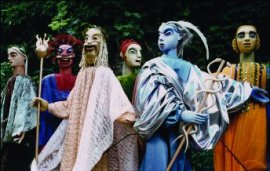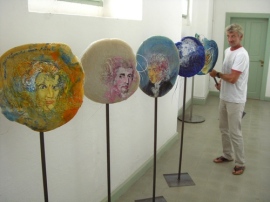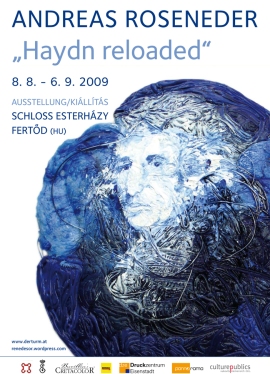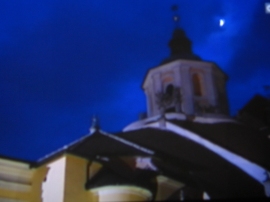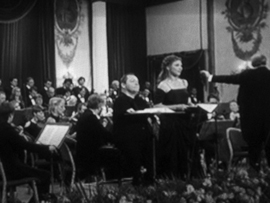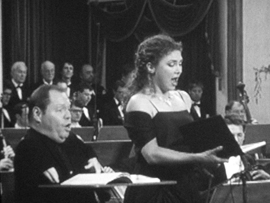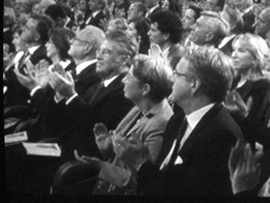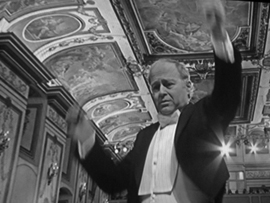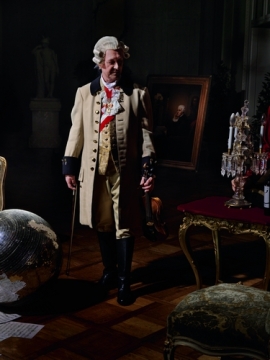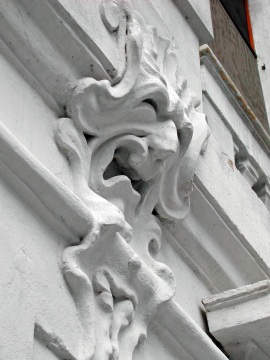200 Years, Anniversary Joseph Haydn (1732-1809)
haydnmania: the 2009 anniversaryArchive for events
what happend today (236 years ago!):
Sept 2, 1773:
PHILEMON UND BAUCIS – Joseph Haydn’s Marionette Opera had premiere at Esterháza (now known as Esterházy Palace, at Fertöd, Hungary)
more:
“If I want to hear good opera I must come to Eszterháza,” Maria Theresa is supposed to have said, giving a somewhat misleading impression. In fact she was there on only one occasion, for the first two days of September 1773. The large scale celebrations were written up in local newspaper reports. On the first day there was a banquet (at which three gamebirds killed by Haydn with one shot were on the Empress’s plate), the inspection of the Park, a performance of Haydn’s opera “L’infedeltà delusa” in the opera house, followed by a fancy-dress ball which lasted till dawn. During an intermission in the ball the Prince showed the imperial party his new Chinese Pleasurehouse. The walls were covered with mirrors which reflected the light of innumerable Chinese lanterns and candles. Haydn and the orchestra played a symphony and other works. The main ball took place in a 130 foot long Chinese gallery adjoining the opera house. Eleven chandeliers and 600 candles illuminated the room and the musicians were dressed in Chinese costume. It was the stove in this room that exploded in 1779 causing the fire that completely destroyed the first opera house and, far worse, all the music and parts of the operas written to date with the exception of the scores that Haydn had fortuitously taken to his living quarters some half mile away (still preserved).
The next evening’s entertainment started with Haydn’s specially composed marionette opera “Philemon und Baucis”, or “Jupiter’s journey to Earth”. This could well have been the official opening of the marionette theatre, which, unlike the rebuilt opera house and the Chinese Pleasurehouse, still can be seen, although now used for agricultural purposes. The auditorium was flanked on both sides by caves domed with rockery and sea shells in the fashionable rocaille style. Some of the caves were embellished with fresco paintings, others with miniature fountains.
The puppet opera was followed by a festive supper after which the Prince led the Imperial party through an avenue illuminated with coloured Chinese lanterns to the site of a spectacular firework display. Once seated the Empress lit the first fuse. After the fireworks an outdoor ball took place in a specially prepared arena, lit by more than 20,000 Chinese lanterns and with over a thousand young peasants performing local dances.
The opera was repeated at Eszterháza in 1776, presumably with a less elaborate final tableau, and was then available as two pieces, the prologue on Olympus as “Der Götterrat” and the main opera as “Philemon und Baucis”. At some time in the 19th century the music disappeared completely, though the printed libretto survived. In 1935 a manuscript score from about 1800 of the main opera was discovered in a Paris bookshop, without the prologue and without the final chorus, but with a lot of extraneous material by other composers that could be discarded thanks to the existence of the libretto. Music from earlier in the opera is repeated for the final chorus. It is generally agreed that the first two movements of Symphony No. 50 were the original overture to the prologue. H. C. Robbins Landon prepared a performing version and produced the first recording in Vienna in 1951.
The tale of Philemon and Baucis appears in Book 8 of Ovid’s Metamorphoses. Two tree trunks grow together in a walled enclosure on a hilltop, surrounded by a swamp, in Phrygia. The story is that the gods destroyed the village but left a temple with the old couple to look after it. Their one wish was to die together when their time came and they were transformed into an entwined oak and a lime. The libretto Haydn set is based on a play by the blind Alsatian poet and teacher, Gottlieb Konrad Pfeffel, presumably found and adapted by the Esterházy librarian, Philipp Georg Bader. Gounod composed a version of the story in 1860. In this very French operetta Baucis asks for the return of her youth, Jupiter falls in love with her and a second wish returns her to Philemon and safe old age.
“Haydn reloded” – exhibition at Esterházy Palace (Fertöd, Hungary)
“coming home”: Andreas Roseneder transporting (his) Haydn (-patches) over the corridors to the Gallery at Esterháza Palace for his upcoming exhibition
The Austrian artist Andreas Roseneder is preparing his newest exhibition called “Haydn reloaded”, which will take place at the famous Esterházy Palace in Fertöd, Hungary where Haydn lived and worked for so many years.
2 years artistic work on the surch of the “authentic portrait” examplified on the great composer – executed in various artistic technics & media can be visited from august 8 to september 6, 2009 at Esterházy Palace, Fertöd, Hungary.
Corr.: because of the big success, “Haydn reloaded” was prolonged until september 27!
Esterházy Palace at youtube:
article on Austrian tv station website about the artist Andreas Roseneder, online (german)
pictures of an exhibition:
some impressions of “Haydn reloaded”
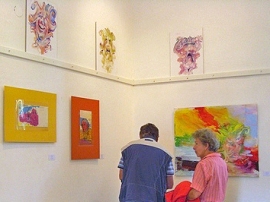
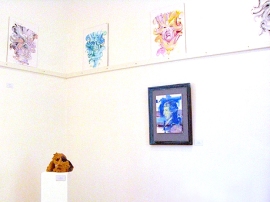
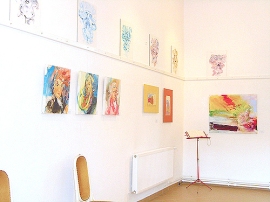
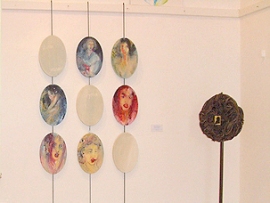

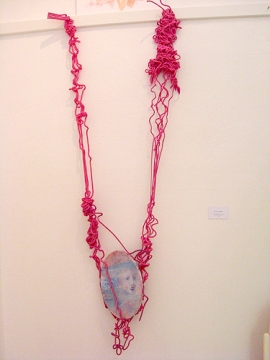
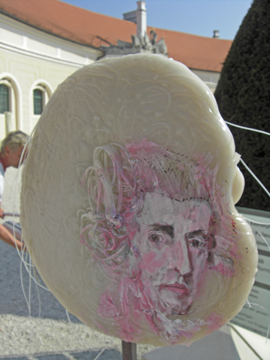
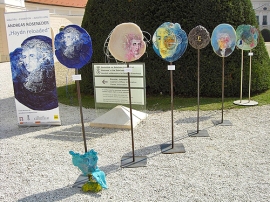
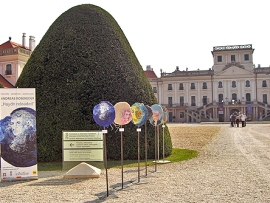
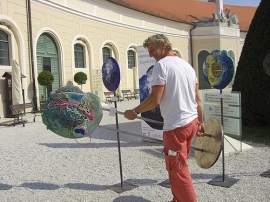
the artist Andreas Roseneder, with one of his “haydn patches”, leaving Esterházy Palace in a good temper: the exhibition was successful, notes in his guestbook show the enthusiasm of the visitors!
visiting Esterhàza Palace (Fertöd, Hungary)
Whow, what an impressive ensemble: Esterháza Castle, at Fertöd, Hungary (google map) – just half an hour to go, from the Austria-Hungarian border at Sopron!
1767 Prince Nikolaus (later called “the Magnificent”) visited Versailles and became inspired to build this Castle – on a place that, at this time, was “in the middle of nowhere”.
1768 also a Opera house was built there – the first performance was Haydn’s opera “Lo speciale”.

the 2 scultptures (here the model) of Haydn (left) and the Prince Esterházy (up on the balcony) will be built in bronce next year.
The most famous and importend people of the aera have spent time here, e.g. Empress Maria Theresia loved to be a guest in Esterháza, ’cause “…if you want to listen to the best music you have to go to Esterháza…”.
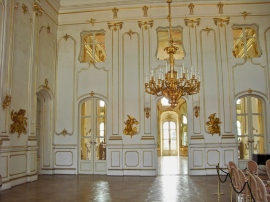

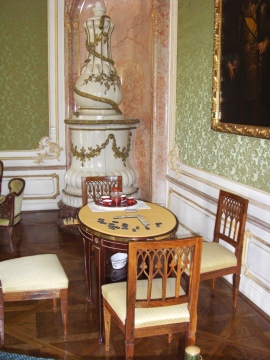
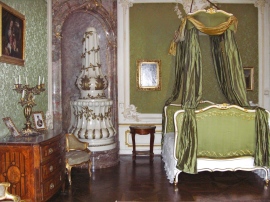
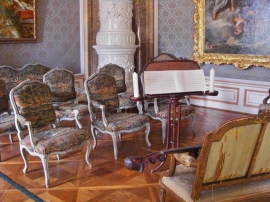
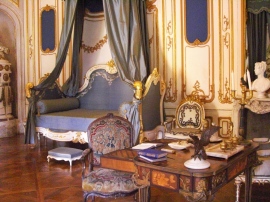
the male’s (prince’s) bedroom with the “secret” door:

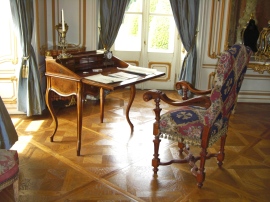
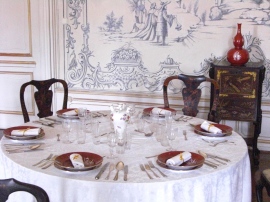
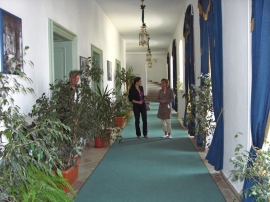
What I have to mention: all the people working in Esterháza were overwhelming friendly and gracious (special thanks to Erna and Tünde!), tried very patiently to answer all our questions and celebrated great hospitality. At least we spent more than 5 hours (!) there – and did not see yet the gigantic historic gardens!
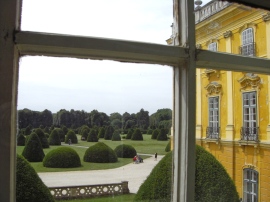
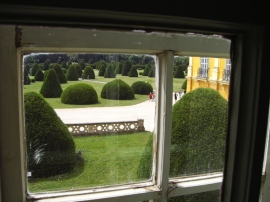
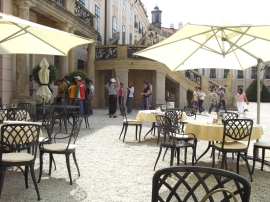
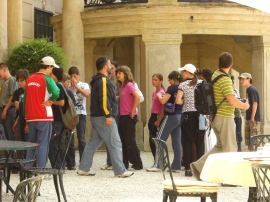
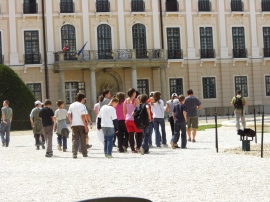
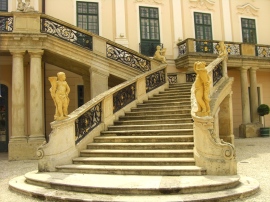
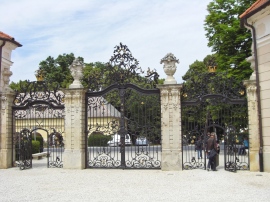
Prince Paul Anton still lives there, although the Esterháza Palace today belongs to the National Administration Departement of Historical Buildings.
Enjoy a visit there! And one of the exhibitions or one of the many concerts during the Haydn-anniversary-year!
On saturday, august 8, 2009 the opening event of an extraordinary exhibition of contemporary art starts at Esterháza Castle:

Andreas Roseneder: “Haydn reloaded” – a modern painters view on the genius, his life and works and his surrounding. New paintings and objects as result of Roseneder’s artwork about Haydn.
link: www.mag.hu
“Haydn explosive” – an extraordinary exhibition!
This weekend I visited the “Haydn explosive. A European career at the court of the Esterházy Princes”- exhibition of the Esterházy Foundation at Schloss Esterházy at Eisenstadt.
Whow!
The Impressions I got were beyond comprehension: so poignant and overwhelming! And too much for one visit! If you go there, take time – one hour is almost not enough, believe me! (Ofcourse I plan my next visits there!)
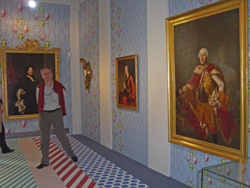
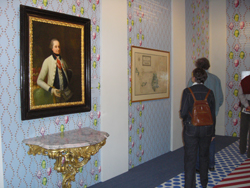
The visitor’s experience starts right at the entrance and one does not know, where to go or look first: the wallpapers of Franz West, the expansive carpet of Roy Lichtenstein – both makes you suddenly feel that this exhibition is different!
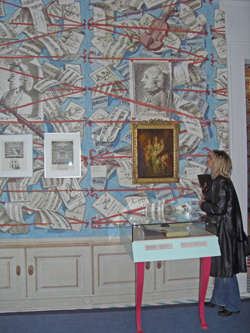
And you walk through the rooms and exhibits with the wide open eyes of a child and a certain explorer-attitude (this was definitely my impression!) to find out more about this genius Haydn and the influences around him today and yesterday!
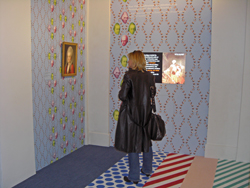
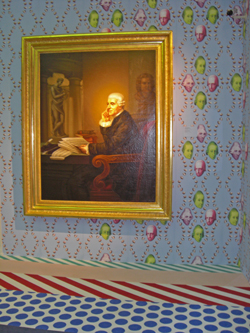
His relationship to the Esterházy-Dynasty, the age of his life and the effects of his works – all these things (and much more!) are presented and documented as well with historical exponats as with contemporary works in a sensational well-founded and appealing way.

Haydn, “pixeled”!
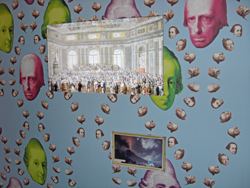
Monitors in the walls present information in a diversified way.
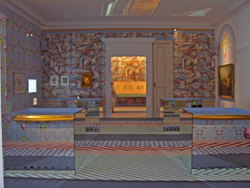
The explosion (videoinstallation) on the ceiling
is connecting the next (musical and visual) experience, the string quartet: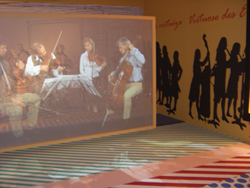

At least you go through the museum shop: books, Cds, ….. – it was too late for me to forage for things that might be interesting for me – because it was closing time! So I have to come once (or twice or …. ) more!
Opening times:
daily from 9 am to 6 pm
Sala Terrena, Esterházy
Palace, Eisenstadt
Gala concert with the prizewinners
picture © “haydn explosive”, Esterházy Foundation
The “International Joseph Haydn Chamber Music Competition” organised by the University of Music in Vienna has been held ever since 2001. An eminent international jury elects the participants.
As a tribute to Haydn – the composer of genius – on the bicentenary of his death, the competition is being held a year early instead of retaining the triennial interval.
The 4th competition took place in Vienna from 15 to 23 April 2009, and the grand finale will be the galaconcert on friday, april 24 at Schloss Esterházy (Haydnsaal), Eisenstadt at 7.30 pm played by the prizewinners, organised by the Esterházy Private Foundation .
A novelty of this year’s anniversary competition will be the presentation of new compositions by the composition classes of the University of Music and the Performing Arts.
amendment:
the audience’s prize ( € 4.000,-) was won by the polish-german “Berolina Trio”
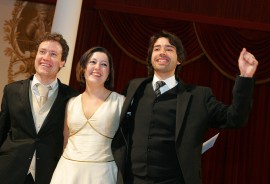
Fotocredit: F.E. Familien-Privatstiftung Schloss Eisenstadt /APA-OTS/Peter Hautzinger.
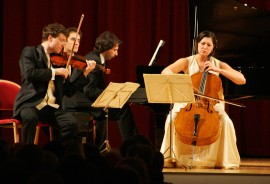
Fotocredit: F.E. Familien-Privatstiftung Schloss Eisenstadt /APA-OTS/Peter Hautzinger
to immerse oneself into the Haydn era

© Schloss Esterhazy Management, pressfoto
The “official” ehibition (by Burgenland governement) to the Haydn-Anniversary, “Phänomen Haydn” was opened. On 4 locations in Eisenstadt visitors can get an idea of Haydn’s era, the circumstances of his life & believe – if you like to immerse into a past era.
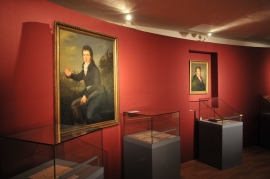
©Haydn 2009, pressfoto by W.Simlinger
The exhibition has nothing to do with any contemporary view on Haydn’s work or life – just focused on the past.
More inspiring, modern and interesting for a nowadays contemporary view on Haydn is the exhibition of the former “employers” of Haydn, the Esterházys at their exhibition “Haydn explosiv”. More about that soon here!
happy birthday, Joe!
one of the grimaces in the inner courtyard at Schloss Esterházy Haydn would have been admidst ….
… that inspirated modern painter Andreas Roseneder (his language is also “understood throughout the world”) to his “mask”-series (2008, 2009), more
Today, on Joseph Haydn’s 277th birthday (born 31 march, 1732 in Rohrau) the “official” Burgenland starts with the celebration years program at Schloss Esterházy in Eisenstadt.
And there will be some things similar to Haydn’s conditions of employment during his 30 years at the court of the Esterházy’s, when he composed and played for the aristocrat familiy and their guests:
also today and tomorrow Nikolaus Harnoncourt and his Concentus Musicus (with an excellent Haydn-program!) will only be heard by a privileged scene of invited politicians, economic people, sponsors and – more or less – public characters of the “scene” – and journalists!
It’s a question of private imagination power to realize, how many percent of today’s listeners at the Haydn-Celebration-Year opening love music, especially Haydn’s music – or take just a seat in the famous Haydnsaal and try to show the own face in some jounalist’s camera for own promotion aims and commercial reasons ..
ugh…..
In the meantime a lot of Haydn-lovers celebrate their much-admired “Genius Loci” at their players by listening to the wonderful masterpieces of music that enhance their lifes since mor than 2 and a half centuries.
-and so will I!
Salute, Joe!

